- Learning time
- 10 minutes
- First play time
- 30 minutes
Iron Curtain
Designed by: Asger Harding Granerud,Daniel Skjold Pedersen
The Cold War era has long-fascinated game designers, with Twilight Struggle being the acknowledged jewel in the crown of two player US/Soviet face offs. So if you have a hankering for some ideological world domination but don’t have the requisite three hours playtime/bottomless attention span, Iron Curtain distils the entire Cold War experience down to just 18 cards and a handful of wooden cubes, and plays in about 20 minutes.
The players represent the US and Soviet superpowers, and are vying for control of six areas; Europe, Middle East, Africa, Asia, Central and South America over two rounds. In each round the players will have a hand of cards representing parts of these battlegrounds, and will alternate placing them on the able to form a map. But while cards must be placed adjacent to others of the same region, there’s no requirement to conform to geography as we know it; each game can end up looking very different on the table. Each card played will have two other attributes – an event, which will be for either the US or Soviets, and a number of operations points, allowing you to place some cubes adjacent to areas you already occupy. You can choose to do either the event or use the ops points, but if the event is for your opponent, it will trigger automatically. Fans of the aforementioned Twilight Struggle will recognise these mechanisms, but whereas in that game you are playing cubes to a stylised map of the world, the decisions of where to place each new continent in Iron Curtain offer a lot of strategic depth in such a small, pared-down game. The goal is to have more cubes on the map than your opponent, and as the last card of each continent is placed, the dominant player will score points. Again, like Twilight Struggle, the score track is a tug of war, and if the score marker ever makes it all the way to one side, that player wins.
At the end of the first round, each player plays their last card face down as an ‘aftermath’ card, and at the end of the game, before final scoring, these are revealed. The operations points on them score for the player whose event is listed on the card, and again the game can end here. But if the score marker has not been pulled all the way to one end, all the continents are scored, in specific order, and the winner is declared.
Iron Curtain is a micro affair that exudes tension in each of the mere nine cards played by each side. Within its miniscule framework there’s plenty of room for doublethink, strategic placement of cubes and map-building; and while there are a fair few games that have tried to boil such a big experience down into a small package, Iron Curtain stands out as a really successful gaming experience in its own right.
Joe says
Of all the micro games that have attempted to distill a real-world conflict down to bare essentials, Iron Curtain is the one for me that feels most like a proper game. The history is worn lightly, and the geography is totally up for grabs - you can stick Africa on to the end of South America if want - but that's really the point. The map you build is a psycho-geography of the conflict, and the spacial element is, along with the cards and cubes played, a key strategic part of the game. It can be quite swingy - it seems to me I can often tell after the first round whether I have a chance of winning or not - but by then you're 10 minutes in and halfway through the whole game, so it's not a huge investment of time. And the asymmetry is really interesting - you can make a session two games, where you each play out both superpowers, and see who wins overall. A brilliant little game.
The guru's verdict

-
Take That!
Take That!
Not one for those that dislike direct confrontation - though it's domination of areas rather than putting holes in each other.
-
Fidget Factor!
Fidget Factor!
Very little downtime, as you'd expect from such a small game.
-
Brain Burn!
Brain Burn!
It's definitely a help once you've played enough to know what events are going to come up - but there are only 18 cards in total, so it's not too daunting a prospect. In fact, if you like the idea of knowing a game so well you can recall all the possible events at will, Iron Curtain would be a great one to start with.
-
Again Again!
Again Again!
Despite it's tiny form factor, no two games will be alike - there appears to be a huge amount of replayability here.


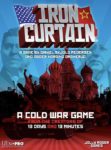
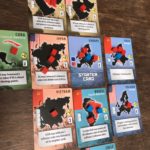







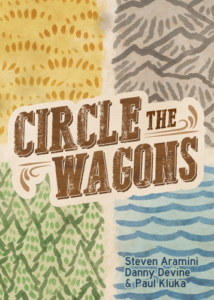
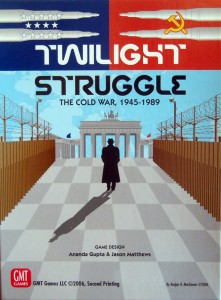
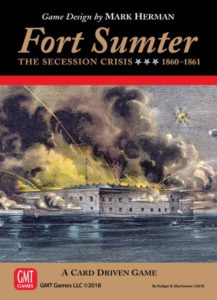
Sam says
I'm not as familiar with Iron Curtain as Joe (below) is, but having tried several two-player war games in Cousin's War, 13 Minutes and Fort Sumter I expected this to be the same type of experience; an abstracted push-pull of cubes denoting control; and the type of game I don't find particularly engaging. But whilst there are similarities, Iron Curtain surprised me.The fact players are laying out a tableau as they play is a neat twist because which card you place where is important, as you can only have influence in areas adjacent to where you have influence already. The minimalist deck means frequent visits will add another dimension to play as well - when you know what the events are on each card you can start factoring that in to your decision-making: not just your own cards but what your opponent might have. Very clever, and a lot of game bundled up in a small package.